Meet Frankie, which is short for Frankenkitten. He has born with four ears and had to have one of his eyes removed. After going through his daunting fate, this little fellow has adapted to living in the big world with his foster family that is there to help him every step of the way, writes catlov.
Frankie was born with four ears under a suburban house where he was found with another sibling
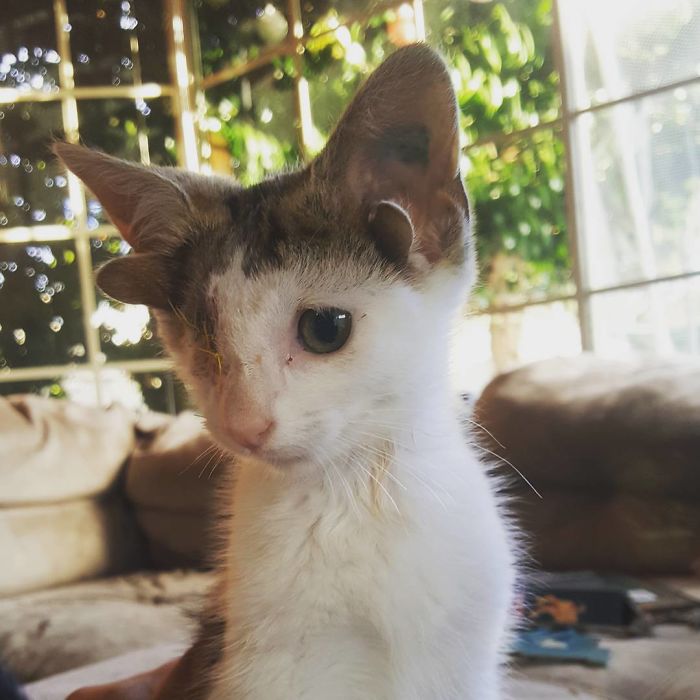
“He was born under a suburban house to a feral mother,” Frankie’s owner, Georgi Anderson. “He was found with one living sibling but there may have been more that did not survive. The homeowners took Frankie and his brother in for several weeks to socialize them and fatten them up before bringing them to the shelter for medical care and rehoming.”

“He also has a very large overbite which gives his face a very angular appearance. He did come into the animal shelter with 2 eyes, but one eye had ruptured and needed removing. Frankie also has joint problems in his hind legs – his knees don’t sit properly in place, so he walks splay-legged and his knees often slide in and out of place.”
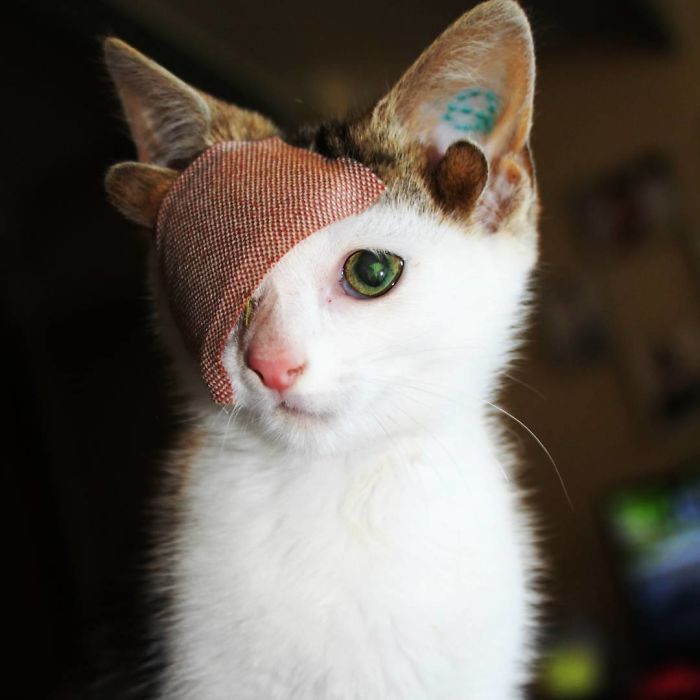

“Because of the overbite, his lower canines were piercing through the roof of his mouth. He also needs his knees operated on to stabilize the joints but I am saving the money for that, it’s quite expensive,” Georgi said. “He has also had dental work done to cut his lower canines to just a few mm above the gum line.”
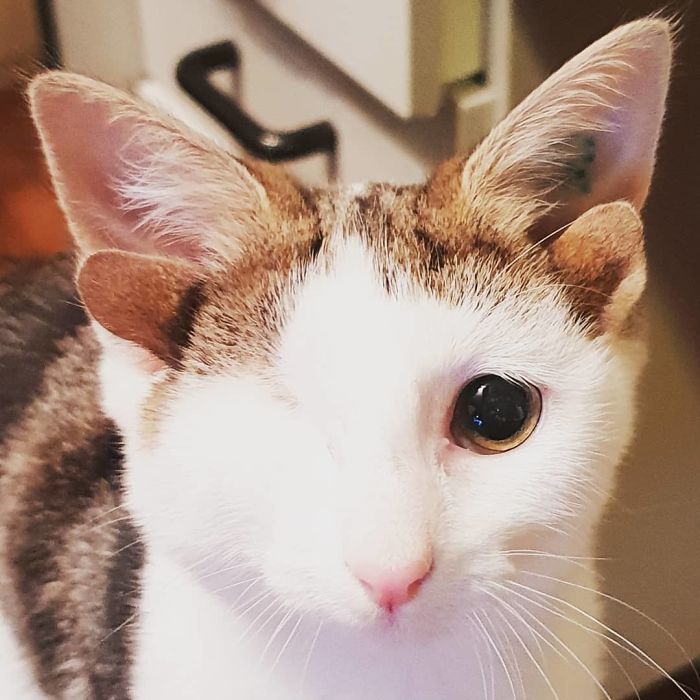
“He did come into the animal shelter with 2 eyes, but one eye had ruptured and needed removing”
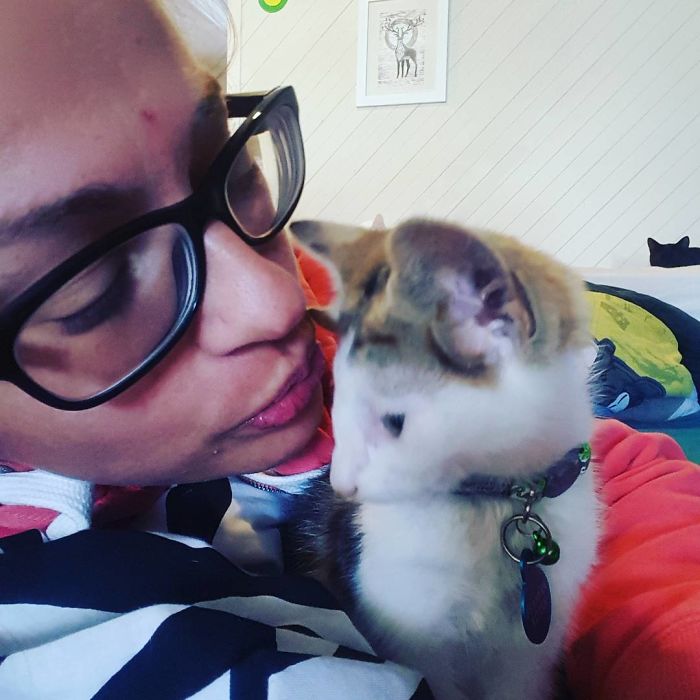
“The eye removal allowed him to survive as the infection would have become septic and killed him.”
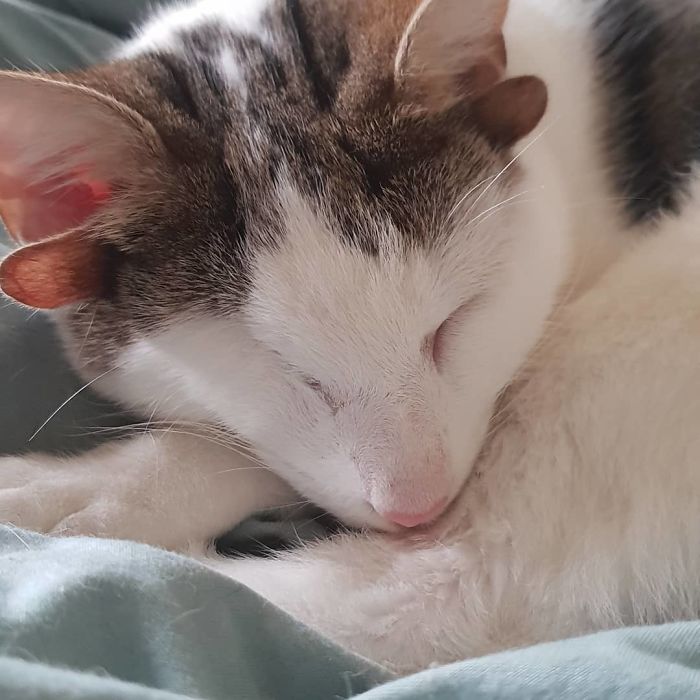
“I worked at the animal shelter at the time that Frankie came in. I was also a foster carer so I was asked to foster him for a week as he recovered from the eye removal”

“It wasn’t so much his unique look that sold him to me — it was his sweet demeanor, the way he explored his surroundings, and seek comfort from me”

“I went and saw him prior to his procedure and right away was struck by how sweet-natured he was. After a few hours of having him home in recovery, I knew he was special in a way I couldn’t quite describe.”

“The physical aspect of his condition has some impact on his everyday life. The little front ears mildly affect his directional hearing, as they almost act like little earmuffs to his proper ears. He has adjusted well to only having one eye, but I can tell his night vision is not as good as my other cats’. His legs cause him to walk splay-legged but don’t cause pain or affect the way he plays or jumps. His mouth probably is the biggest physical factor — he struggles to eat wet food because he can’t get a good grasp on it. He is on a dry food-only diet and has learned to pick kibble with his tongue and bring it into his mouth that way, rather than using his teeth.”
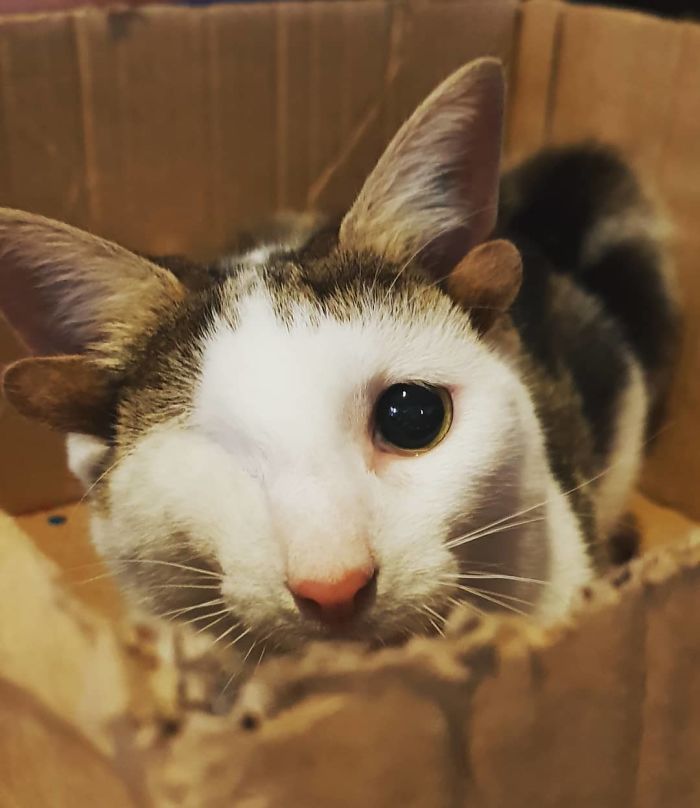
“A normal day for Frankie is picking different places to curl up and sleep, ambushing me every morning while I make breakfast — he likes to try and climb up my leg and then darts off like a lunatic”
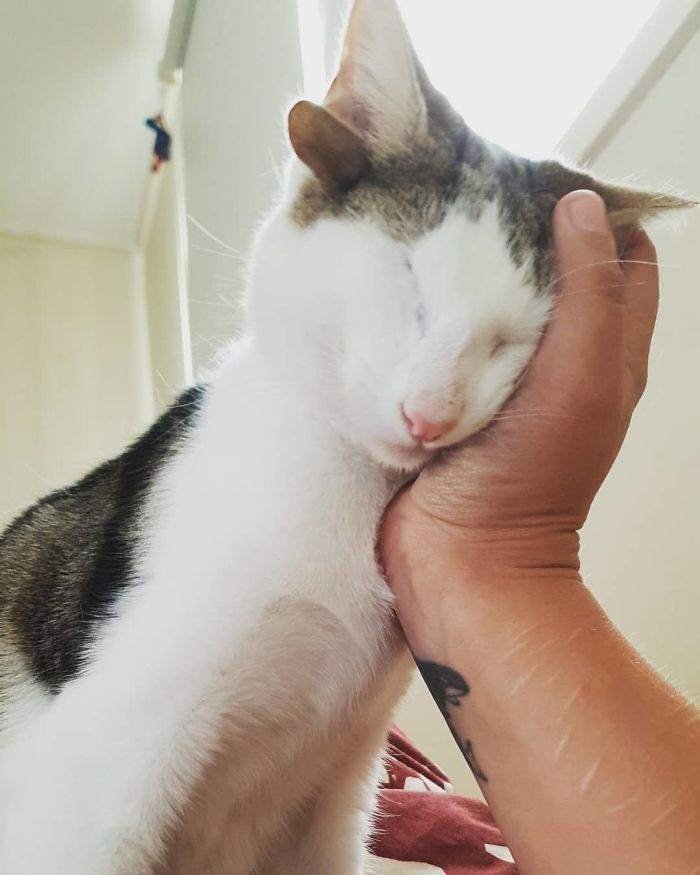
“Playing with his brother Lucius Malfoy. Annoying his older siblings Minako and Toothless”

“He sleeps a bit more… a lot more. Then annoys the dogs. He is a very cheeky character”

“His personality is very cheeky, but he gets away with it because he is also very sweet. He is not overly intelligent which has been a noticed trait in some other cats with 4 ears. I doubt he would fare well outside. He would see a car and think it was something to play with. But he is so loving and affectionate and seems to sense when I have had a difficult day. I almost would say he has a doglike personality.”
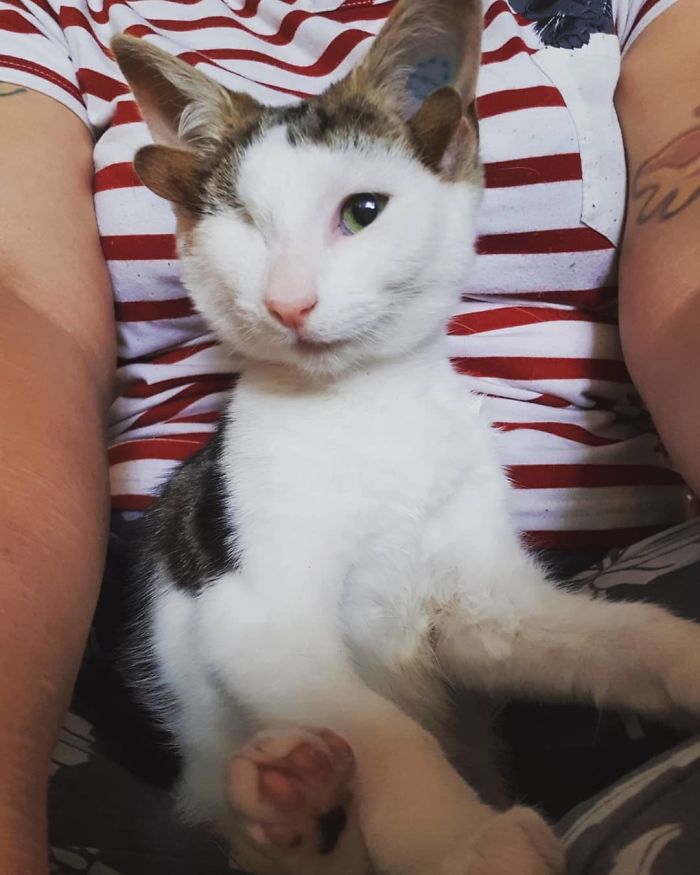
Frankie is living proof that true beauty is from within. He and his humans are lucky to have each other and something tells us they are gonna be ok.
This story originally appeared in catlov.com
6 Most Common Cat Health Problems
Cats are good at self-maintenance. But even your fastidious feline can't prevent some of these more common cat diseases and health issues.
1. Vomiting
Vomiting is a very common problem with cats with a multitude of causes. They range from eating something poisonous or inedible (like string), to infection, urinary tract disease, or diabetes to hairballs.
Symptoms are usually obvious, and include drooling and abdominal heaving. Vomiting can quickly leave your cat dehydrated, so if kitty continues vomiting or acts ill, call your vet right away. It may help to collect a sample of your cat's vomit and take it with you to the vet.
2. Feline Lower Urinary Tract Diseases (FLUTD)
Some estimates say as many as 3% of cats seen by vets have feline lower urinary tract disease ( FLUTD), which is actually a group of feline diseases with multiple causes.
Female and male cats can get FLUTD, and it often occurs in cats that are overweight or unfit or who eat dry food. Stress, a multi-cat household, and sudden changes can all raise a cat's risk of FLUTD, and treatment depends on the type of FLUTD your cat has.
FLUTD symptoms include:
- Straining to urinate
- Bloody urine
- Urinating in unusual places
- Crying when urinating
- Licking around the urinary area (often because of pain)
- Depression
- Dehydration
- Lack of appetite
- Vomiting
It's always an emergency if your cat can't urinate. Call your vet immediately if you suspect your cat has a urinary tract problem.
3. Fleas
Fleas are a very common external feline health problem. But it's one you can easily treat. Signs your cat has fleas include:
- Flea dirt on its skin (they look like tiny black dots)
- Constant scratching
- Frequent licking
- Red or irritated skin
- Hair loss
- Skin infections or hot spots
Fleas can live for more than a year, and your cat risks anemia if the problem becomes serious, so be sure to treat your cat's flea problem and prevent future infestations.
Talk to your vet about which flea control would be best for your cat. Treatments include oral medication, powders, foams, and topical medication. Fleas are uncommon in Utah. If you adopt a pet from a region outside of Utah or are housing a pet that recently came from another state, please be aware of fleas.
4. Tapeworms
One of the most common feline health problems inside your cat, tapeworms live in kitty's small intestine and sometimes grow as long as 2 feet.
Symptoms of a tapeworm infection can be subtle but may include vomiting and weight loss. The easiest way to tell if your cat has tapeworms is to look at its feces and around its anus. If you see small white worms or what look like grains of rice or sesame seeds, your cat likely has tapeworms.
Treatment options include injection, oral, or topical medication. But because cats almost always get tapeworms as a result of swallowing a flea, be sure to handle any flea problems your cat has before tackling tapeworms.
5. Diarrhea
Many things can cause diarrhea in cats, including spoiled food, allergies, infection, liver disease, cancer, and more.
Symptoms of diarrhea are loose, watery, or liquid stool. Depending on its cause, diarrhea can last for a day, a week, or months.
If your cat has diarrhea, offer kitty plenty of fresh, clean water to prevent dehydration. Then remove kitty's food for no more than 12 to 24 hours. Take your cat to the vet if he or she still has diarrhea after a day or immediately if you notice vomiting, dark, or bloody stools, fever, lethargy, or loss of appetite or if your cat is straining to defecate.
6. Eye Problems
Eye problems in cats can be caused by a number of things, including conjunctivitis, cataracts, glaucoma, trauma, viruses, inflammation, and retinal disease.
A few symptoms that may mean your cat has eye problems include watery eyes, tear-stained fur, cloudiness, red or white eyelid linings, gunk in the corners of the eye, squinting, pawing at the eye, or a visible third eyelid.
Unless you know what's causing your cat's eye problems, there isn't much you can do other than wipe away any gunk with a damp cotton ball. After that, call your vet.




GIPHY App Key not set. Please check settings